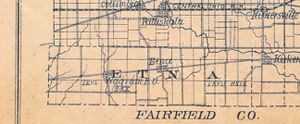Etna Township
Etna Township was known in the nineteenth century for its productive farmland. It was first settled by Europeans in 1815 and organized as a township in 1833. A slight adjustment to its territory occurred in 1850 when a small, half-mile sliver of land was ceded to Harrison Township. [1] Two villages were laid out in the township at about the same time in the early 1830s. Cumberland, later called Wagram, was the westernmost village. Its founder, Jerry Armstrong, hoped for a grander town but Wagram eventually became one of Licking County's numerous "Ghost Towns." [2]
Its first village was named Carthage—soon remained Etna—and plotted by Lyman Terrell in 1832. Like many of the villages across southern Licking County, the new village of Carthage/Etna was sited along the proposed route of the [National Road] and hoped to benefit from its impending arrival. A village did grow at Etna thanks to the influx of travelers on the National Road, yet other problems, such as an outbreak of cholera in 1834 and small pox in 1845 came with the travelers. Etna would peak at a population of around 300 inhabitants before the rise of railroads shifted commerce and travel away from the National Road. [3] Local chronicler Morris Schaff claimed that Terrell renamed the village after learning that the site sat at the highest point on that section of the National Road. [4]
Recent Growth
Unlike many traditionally rural parts of Licking County, Etna Township has experienced rapid and sustained growth in recent decades as Columbus and its suburbs expand eastward. In 2010, Etna Township had a population of 16,373 [5] This is a dramatic increase from the roughly 1200 inhabitants the area had in 1870, and much different that the limited population growth, or even decline, experienced by other townships. [6] Bisected by both I-70 and US-40, the township has become a favored location for distribution warehouse construction, most notably an Amazon Fulfillment Center. Etna village has grown but much of the population increase stems from the growth of Reynoldsburg in neighboring Franklin County. These changes, also occurring in Pataskala Township in the 2010s and 2020s, are transforming a once rural area into a residential and commercial hub.
For more information see:
Helwig, Richard M. and Helwig, Richard N. Ohio Ghost Towns: No. 44 Licking County. Sunbury, OH: Classroom Museum Products, 1998.
Schaff, Morris. Etna and Kirkersville. Boston and New York: Houghton, Mifflin and Company, 1905.
J.G.
Return to Townships and Communities main page.
References
- ↑ Brister, E., Centennial History, (1909), 413
- ↑ Brister, E., Centennial History, (1909), 414
- ↑ Brister, E., Centennial History, (1909), 414
- ↑ Shaff, M., Etna and Kirkersville, (1905), 6
- ↑ https://lickingcounty.gov/civicax/filebank/blobdload.aspx?BlobID=49095
- ↑ Smucker, I., Centennial History, (1876), 23
